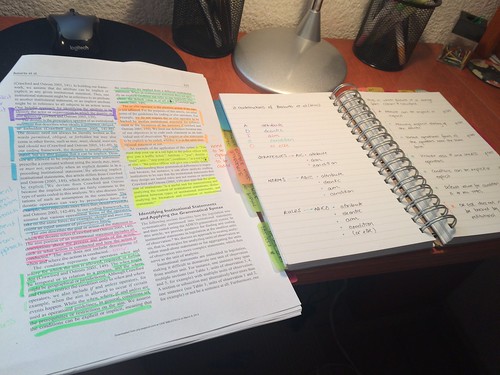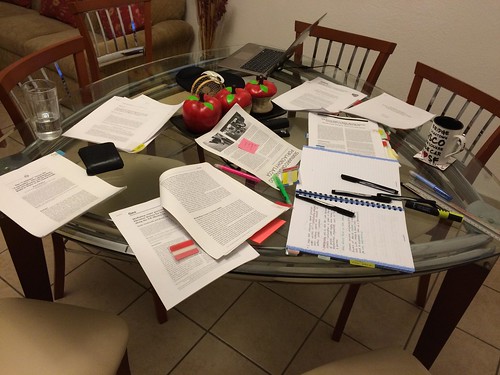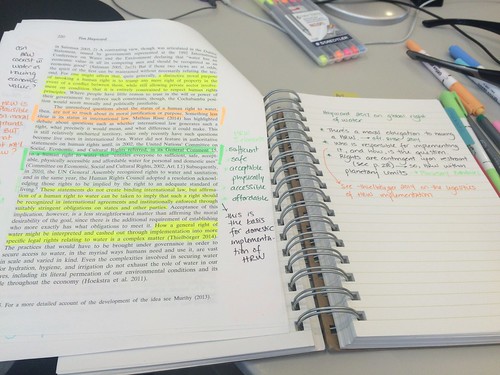I’ve written before about reading strategies: how to extract relevant information from a journal article or a book chapter (the AIC method); I’ve also discussed how I engage when I can only skim a paper, and a meso-level type of engagement when I have *some* time to read (or I’m doing a preliminary survey of the literature). But there are times when you literally MUST engage with the readings on a very deep level. That’s what I call deep engagement (and what most professors and PhD supervisors expect from their students, be it undergraduate or graduate). In this post I’ll describe a little bit of the process that I use when I have to engage deeply with a specific set of scholarship.
Right now I’m writing a literature review on Elinor Ostrom and Sue Crawford’s grammar of institutions. This is a topic I know it’s relatively unexplored and I also know the authors who have used the grammar itself. So, I chose five articles (including the main one, Ostrom and Crawford 1995) and a few of those who have referenced that article. I knew I needed to really engage with the readings because this is a method that, while I’m very familiar with it, I have still yet to apply in a more systematic way in my own research.
The way I approach articles that I need to engage with rather deeply uses a three-pronged strategy: I book time to read (usually a couple of hours, but there are times when I book an entire day), open a Word file to write an in-depth memorandum, and open Excel so I can simultaneously dump quotations on my Conceptual Synthesis spreadsheet. Since I know I’ll be writing text that I will be using for a paper anyways, I do count this time as part of my 2-hours-per-day block.
I also keep related papers on a similar topic physically close to me so that I can write on the connections that each one has. For example, in my reading on applications of the institutional grammar tool, I know four of the authors who have ran codifications of specific pieces of legislation (David P. Carter, Christopher Weible, Xavier Basurto and Saba Siddiki). So I printed out the papers where these authors applied the tool, and read them all within the same session. That way I am able to (a) discern the contributions of each one of the papers they wrote, (b) connect the different pieces of work that are associated with the core concept (Crawford and Ostrom’s institutional grammar tool) and (c) write an in-depth, detailed memorandum that can serve as one of the core components of the main body of a paper I am writing. I also keep Mendeley open as I often need to insert citations into the text of a memorandum, where I use Mendeley’s Cite-O-Matic function.
When I read, I use colour-coded highlighting techniques, where I mark the main ideas in a specific colour and I associate them with their corresponding concept. That way, I can recall, understand and memorize more easily. For example, the method uses a grammar with five different codes (ADICO). So I used five different colours for highlighting each one of the operators AND to scribble notes on the margins (and on my Everything Notebook) that would be cross-linked.
The example I show below isn’t specific to the grammar of institutions, but it shows how I cross-link my scribbles and highlighted sections with notes on my Everything Notebook. What I find hardest when engaging deeply with the literature is controlling the urge of jumping to a different topic or another paper (I’ve written before about how hard it is for me to concentrate and why I use a few strategies to regain focus). So when I know I need to engage deeply with the literature, I try to do it during my buffer day (the day I use to catch up on reading). That way, I don’t have any urgent meetings to attend to, any must-do administrative chores, or lectures to prepare. Engaging deeply requires, for better or worse, that we make the time to read, and that we also invest in writing memoranda, dumping quotations on the Conceptual Synthesis Excel Worksheet, and (if necessary) clean up references on Mendeley (as I normally do on a regular basis, as it’s part of the academic grunt work).
Following my three-pronged strategy to engage deeply with the literature generates 3 things, for me: A set of memorandums that I can use as input for a specific paper draft; a set of entries on my Excel Conceptual Synthesis worksheet that also include specific quotations that can help me with the literature review and with drafting the paper, and a set of handwritten notes on my Everything Notebook that I can also use for the paper I am writing. So I do not find engaging deeply with the literature to be a problem or a waste of time, but it is an investment that will pay off as it will be easier (and faster) for me to write a paper since I already have read in-depth and understood the literature that is associated with said paper.
Engaging deeply with readings is a time investment, that IS why I do it.





One Response
Stay in touch with the conversation, subscribe to the RSS feed for comments on this post.
Continuing the Discussion